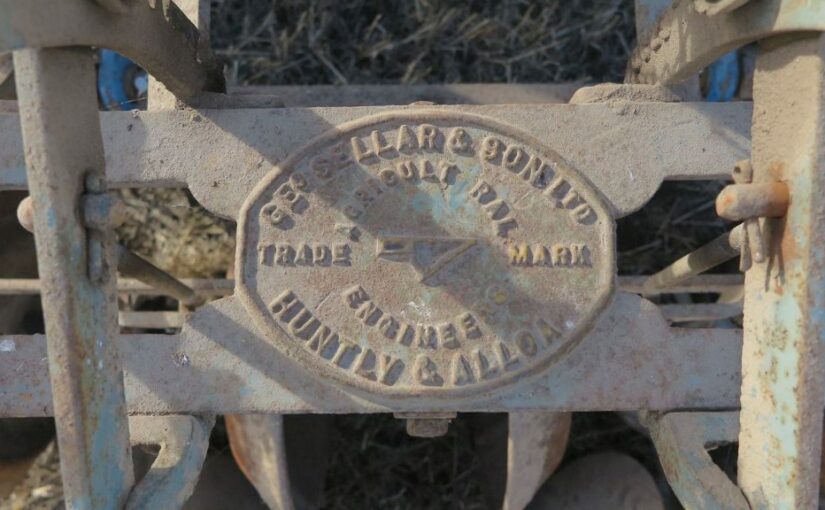Readers of this blog are familiar with the name of George Sellar & Son, Huntly in relation to the making of ploughs and other tillage implements and machines.
Back in the 1880s the business was continuing to manufacture its wide range of ploughs, including its well-known ones. But it was also turning its attention to new ones including the chilled ploughs that were attracting the attention of farmers. It exhibited its “well-known” ones at the Highland and Agricultural Society’s Show at Dumfries in July 1886 (see Aberdeen press and journal, 27 July 1886). It also exhibited its “celebrated ploughs”, as well as its other implements including grubbers, patent diggers, harrows, horse hoes.
The Aberdeen press and journal of 22 July 1886 provided a lengthy description of its chilled plough (Anglo-American) at the Royal Northern Agricultural Society. It is worth quoting at length:
“George Sellar & Son, Huntly, have an exhibition of ploughs, harrows, grubbers, &c, all showing very good and careful workmanship. The specimens of common ploughs are of very high order, and, judging from appearances, look extremely like their work. What will attract the attention of farmers most will be the Anglo-American ploughs, which gained the prize of £5 at the Highland Society’s trial in autumn, and which since then have been improved, and been most successful at ploughing matches. The plough, which is styled no. 1, has a steel board (it can also be fitted with a chilled metal one), and steel shares. These shares are said to be very economical. The work done by the plough, while not so much flattened as by the ordinary American plough, is quite as well pulverised, this leaving a rich and level seed-bed. Amongst Messrs Sellar’s other exhibits are two sets of harrows with steel tines firmly fixed into holes in the beams, thus avoiding all bolts which are so injurious to harrows; also steel grubbers, which appear to be what every grubber ought to be-a good combination of strength and lightness. Their turnip machine appears to be a handy article. The seed can be seen passing from the boxes into the pipes, and thus any boy that can drive a pair of horses can quite safely be trusted to perform the work of sowing, which only a skilled man could do formerly.”
That newspaper continued to provide extensive accounts of its stands at that show in the following year. On 21 July 1887 it published this account:
“Royal Northern Agricultural Society – the summer show
George Sellar & Son, Huntly, shows a large assortment of ploughs, grubbers, and other implements, for the manufacture of which the firm has become famous. Their no. 1 Anglo-American plough, as far as can be gathered from testimonials granted by many of our most practical farmers, is likely in most cases, even among lea, to supersede the common ploughs. It is lighter in draught, and does not cost nearly so much to keep up. One farmer ploughed 20 acres at a cost of 2d, and the whole season’s wear cost him only 8d. The principle of the plough is slightly different from the American with hollow board. It does not pulverise the furrow slice until it is half turned over, A finer seed bed is thus formed, and the furrow slice gets more thoroughly pulverised. They show an American plough with a hollow board, on which they have made several improvements. The sheath is made of wrought-iron and the side-plate and sole forms the cutting breast. The parts, therefore, that wear most can thus at very little expense be easily renewed, while the sheath and other parts which do not wear, being made of wrought-iron, cannot break or give way. They show a fine selection of well-furnished common ploughs. One of them has a new mould board, styled no. 7, which the firm aver is superior to the no. 8, and is slightly shorter. The steal grubbers on this stand are a splendid combination of strength and lightness. They also show a collection of harrows with steel tines driven into slots in the beam scufflers, and a turnip sowing machine of very improved style.”
These favourable accounts continued to be published by that newspaper in following years. Another was in conjunction with the Spring Show of the Royal Northern Agricultural Society. In March 1888. In its pages of 10 March 1888 it wrote:
“Messrs George Sellar & Son, Huntly had a very fine collection of their celebrated ploughs, harrows, and grubbers forward. Not a little attention was centred in their common swing and chilled ploughs, from the fact that they secured for the holders at the Morayshire champion competition last Saturday the first prize in the medal competition, and also in the trial for chilled ploughs. They likewise exhibited their steel grubbers, which are in great demand again this season. The whole frame is made of steel, with wrought-iron wheels, and farmers are coming to see the advantage of lightness combined with strength for these important tillers of the soil. This firm now manufacture their harrows entirely from steel; being all blocked out of the solid material with a steel hammer. The strength, durability, and efficiency of these implements is sure to make them highly popular everywhere. Their turnip sower is quite a triumph of genius. The seed-box has a lateral and vertical motion, which put out the seed equally and prevent any choking. The seed can be seen passing from the box into the pipes, while the gearing is so constructed that the machine can be put out or in of grip in a moment at the turnings or otherwise. Their double-mould ploughs are made with this special recommendation, that they lift the finest of the mould on to the top of the drill, and deposit it in the centre, just in the very place where the seed is sown.”
Lots of innovation and developments by an eminent Scottish maker for farmers!
